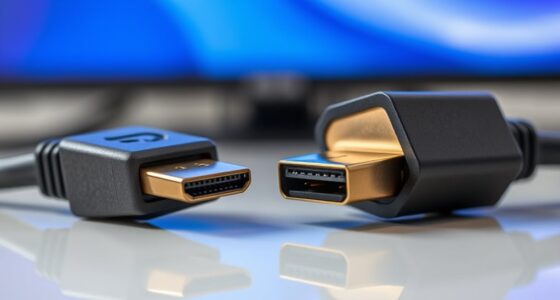MoCA technology lets you use your existing coaxial cables, like those for your cable TV, to create a fast, stable home internet network. It transforms your current wiring into high-speed connections that support streaming, gaming, and smart devices without extra wiring or complex setups. With minimal interference and reliable performance, MoCA offers a practical solution for improving your home’s connectivity. Keep exploring to discover how to set it up and get the best results.
Key Takeaways
- MoCA technology converts existing coaxial cables into a high-speed network for reliable internet connectivity.
- It uses coaxial cables similar to cable TV wiring, avoiding the need for new wiring installations.
- MoCA provides low-latency, stable, and secure internet connections suitable for streaming and smart home devices.
- Proper setup involves inspecting coaxial connections, using quality adapters, and minimizing interference sources.
- MoCA networks can coexist with Wi-Fi and fiber optics, enhancing overall home network performance.
What Is MoCA Technology and How Does It Work
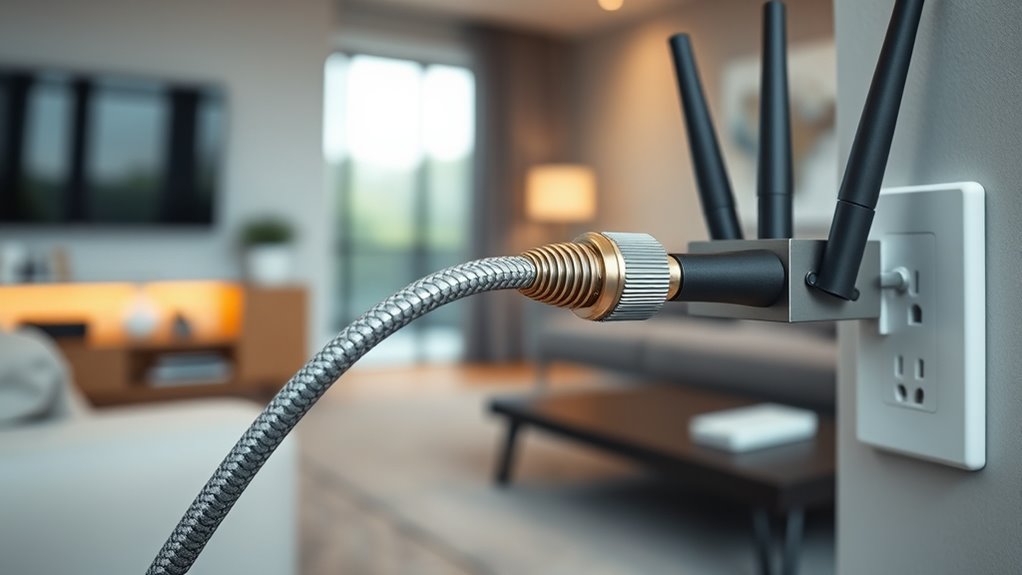
MoCA technology is a reliable way to turn your existing home wiring into a high-speed network. It uses coaxial cables, similar to those that connect your cable TV, to transmit data quickly and securely. Unlike fiber optics, which require new infrastructure, MoCA leverages what you already have, making installation simple. While wireless alternatives like Wi-Fi are popular, they can suffer from interference and dead zones. MoCA offers a stable, low-latency connection that’s ideal for streaming, gaming, and smart home devices. It converts coaxial cables into an Ethernet-like network, ensuring fast, reliable internet throughout your home. This technology provides a seamless alternative to fiber optics or wireless setups, making your network more robust without costly upgrades or complex wiring. Understanding merchant services risks can help ensure your network remains secure and compliant as your home technology evolves. Additionally, the compatibility with existing infrastructure makes MoCA an accessible upgrade for most homes. Incorporating MoCA can also help maximize network performance by reducing congestion and interference.
Benefits of Using Coaxial Cables for Networking

Using coaxial cables for networking offers several key advantages that make them a practical choice for many homes. They provide a reliable, high-speed connection that’s less affected by interference compared to wireless alternatives. While fiber optics deliver exceptional speed and bandwidth, coaxial cables are more affordable and easier to install, especially in existing structures. Unlike wireless options, coaxial networks maintain consistent performance over longer distances without signal degradation. They also leverage your current cable TV infrastructure, eliminating the need for new wiring. This setup offers a stable, low-latency connection suitable for streaming, gaming, and smart home devices. Additionally, wall organization systems can help manage the cables neatly and efficiently, reducing clutter. Coaxial cables are also capable of supporting multiple devices simultaneously, making them well-suited for modern smart homes. Overall, coaxial cables combine affordability, reliability, and ease of use, making them an excellent choice for home networking.
Setting Up a MoCA Network in Your Home

To set up your MoCA network, start by preparing your coaxial lines to guarantee they’re clean and free of damage. Next, connect your MoCA adapters to the coaxial outlets and your devices, following the manufacturer’s instructions. Once everything is connected, you’ll need to configure the adapters to communicate properly across your home’s coaxial wiring.
Preparing Your Coaxial Lines
Have you checked your coaxial cables lately to make sure they’re ready for a MoCA network? Proper preparation guarantees a strong, reliable connection. Inspect your cables for any damage or corrosion, as these can weaken signals. Use signal amplification where needed to boost weak signals, especially in longer runs. Proper cable management helps prevent tangling and reduces interference. Keep cables organized and away from electrical wiring or devices that cause noise. Ensure connectors are tight and secure, minimizing signal loss. Consider replacing outdated or poor-quality cables with newer ones for peak performance. Additionally, verifying the Cultural Impact of technology on your home setup can help optimize your network environment. Being aware of AI security concerns related to modern networking equipment can also help you implement safer configurations. Staying informed about industry trends can help you adapt your setup for future upgrades. By taking these steps, you set the foundation for a smooth MoCA installation, maximizing network stability and speed. Remember, well-prepared coaxial lines are key to a seamless home networking experience.
Configuring MoCA Adapters
Once your coaxial cables are properly inspected and prepared, the next step is to set up your MoCA adapters. Begin by connecting each adapter to your coaxial outlets and plugging them into power sources. Confirm the adapters are compatible with your existing network equipment to avoid compatibility issues. Follow the manufacturer’s instructions to link the adapters via Ethernet cables to your router and devices. During setup, be mindful of signal interference sources, such as splitters or other electronics, which can weaken your connection. Once connected, configure the adapters through their respective apps or web interfaces, if necessary. Confirm that the adapters establish a stable, high-speed connection, and check for any signal interference or compatibility issues to optimize your MoCA network’s performance. Incorporating lifestyle considerations like minimizing clutter and optimizing your workspace can also enhance overall network reliability and ease of use. Additionally, understanding angel number symbolism related to connections can guide you in achieving a more harmonious network setup. To ensure smooth operation, regularly review performance metrics to identify and resolve potential issues early. Paying attention to signal quality can help maintain a robust connection over time.
Choosing the Right MoCA Adapters and Components

Choosing the right MoCA adapters and components is essential for establishing a reliable and high-speed home network. You want devices that seamlessly integrate with your existing setup, whether you’re connecting to fiber optics or using wireless bridges. Consider the compatibility of adapters with your coaxial cables and the speeds they support to match your internet plan. Look for features like built-in encryption for security and backward compatibility with older MoCA versions. Additionally, select adapters that can coexist with your fiber optics network without interference. Confirm the components include quality coaxial cables and splitters to maintain signal integrity. Understanding the shelf life of coaxial cables can help ensure your setup remains effective over time. Being aware of the privacy and cookies policies on your network setup can also help protect your data. Visualize a setup where sleek MoCA adapters connect effortlessly to your router and entertainment devices, creating a robust backbone for streaming, gaming, and browsing.
Installation Tips for a Seamless MoCA Experience

To guarantee your MoCA network performs smoothly, proper installation is key. First, ensure your coaxial cables are compatible with MoCA adapters—using incompatible cables can cause signal interference and weaken your connection. Keep cables away from sources of electrical noise, like fluorescent lights or motors, to reduce potential signal interference. Check that all connectors are secure and tightly fitted; loose connections can disrupt data flow. Avoid splitting signals with incompatible splitters or adding unnecessary adapters, as these can degrade performance. Use high-quality, MoCA-compatible coaxial cables designed for high-frequency signals. Additionally, consider the quality of your existing cabling infrastructure to ensure optimal signal integrity. Be mindful of the signal quality, as it plays a crucial role in maintaining a stable connection. Lastly, keep your setup organized, minimizing bends and avoiding physical damage to cables. These simple steps will help you achieve a seamless, fast, and reliable MoCA network.
Troubleshooting Common MoCA Issues
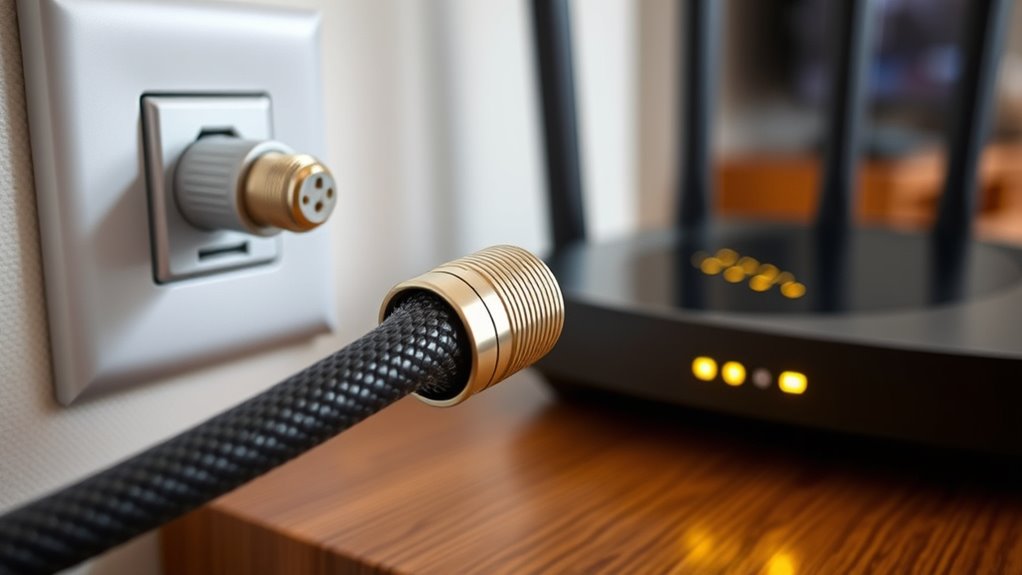
Even with proper installation, MoCA networks can encounter issues that disrupt connectivity. Common problems include signal interference, weak connections, or incompatible coaxial cables. You might also find that your fiber optics setup or wireless mesh network interferes with MoCA signals, causing drops or slow speeds. To troubleshoot, check for loose coax connections, ensure MoCA adapters are on the same frequency, and verify that your coax cables aren’t damaged. Make sure your router’s firmware is up to date. Also, avoid interference from other electronic devices and confirm that your network doesn’t overlap with wireless mesh systems that could cause signal conflicts. Regularly test your network with a MoCA diagnostic tool to pinpoint issues quickly and restore reliable internet access. Additionally, Relationship dynamics such as conflict or emotional distance can sometimes manifest as connectivity issues, so addressing underlying tensions may help improve overall network stability. Maintaining an awareness of home security systems can also prevent unintended interference, as some security devices operate on similar frequencies and could disrupt your network. Being aware of network topology can help optimize signal flow and reduce potential points of failure. Furthermore, checking for signal leakage can prevent external interference from weakening your network connection.
Comparing MoCA to Other Networking Solutions
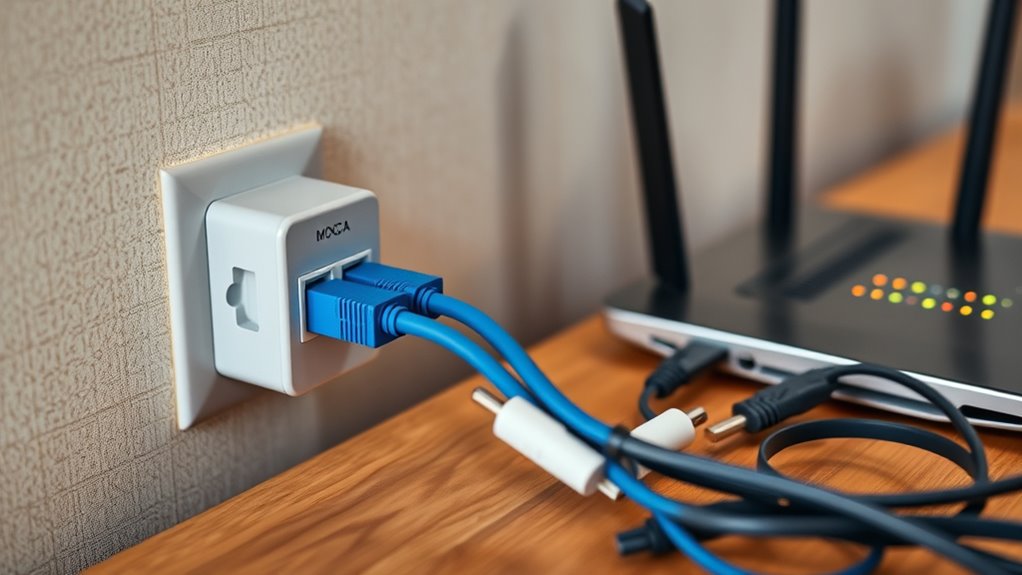
How does MoCA compare to other home networking solutions like Ethernet, Wi-Fi, and powerline adapters? MoCA offers a stable, high-speed connection over coaxial cables, often outperforming wireless alternatives in reliability and consistency. Unlike Wi-Fi, which can be affected by interference or distance, MoCA provides a dedicated, low-latency link suitable for streaming and gaming. Powerline adapters are convenient but tend to have variable speeds depending on your home’s wiring. When comparing fiber optic to MoCA, fiber provides faster speeds over long distances but is more expensive and complex to install. MoCA strikes a balance, offering high performance with easier installation using existing coax wiring. It’s a strong choice for those seeking a reliable, cost-effective network backbone without the complexity of fiber. Additionally, network stability is crucial for maintaining uninterrupted connections, and MoCA excels in providing consistent performance.
Enhancing Network Security With Moca
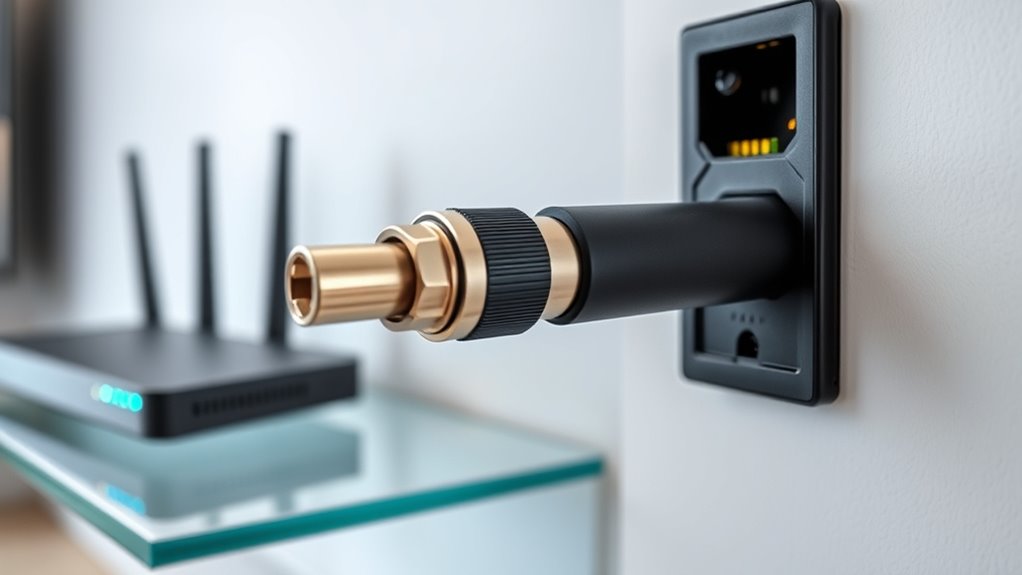
Enhancing your network security with MoCA involves implementing measures that protect your data from unauthorized access and potential threats. Since MoCA uses coaxial cables, it’s inherently more secure than wireless options, but you should still take precautions. Be aware that wireless interference can weaken your network’s signal strength, making it more vulnerable to eavesdropping. To boost security, use strong, unique encryption keys for your MoCA adapters. Place your devices away from sources of wireless interference, like microwaves or cordless phones. Regularly update firmware to patch security vulnerabilities. Consider physically securing your coaxial connections to prevent tampering. Additionally, understanding digital literacy can help you recognize and respond to potential security issues effectively. Utilizing security best practices can further safeguard your network from emerging threats. Visualize:
Secure your MoCA network with strong encryption, firmware updates, and physical safeguards against tampering.
- Locked panel on your coaxial splitter
- Signal strength meters showing full bars
- Encrypted data flowing securely
- Coax cables hidden behind walls
- Network access restricted to authorized devices
Real-World Applications and Use Cases

MoCA technology plays a crucial role in expanding residential broadband, providing reliable high-speed connections throughout your home. It also integrates seamlessly into enterprise networks, enhancing connectivity and performance across office spaces. Understanding these use cases shows how MoCA can address real-world networking challenges effectively.
Residential Broadband Expansion
Expanding residential broadband through MoCA technology brings faster, more reliable internet connections directly into homes, addressing the growing demand for high-speed connectivity. It offers a seamless way to leverage existing coaxial cables instead of relying solely on fiber optics or wireless alternatives. With MoCA, you can enjoy smooth streaming, gaming, and video calls without interruptions. Imagine a household where multiple devices connect effortlessly, eliminating dead zones and buffering issues. Picture your home’s coaxial wiring supporting high-speed data, transforming your internet experience. You might see:
- Streaming 4K content without lag
- Seamless online gaming sessions
- Reliable smart home device connections
- Faster downloads and uploads
- Whole-home coverage without new wiring
MoCA technology enhances residential broadband by maximizing existing infrastructure, making high-speed internet more accessible and dependable.
Enterprise Network Integration
Integrating MoCA technology into enterprise networks leverages existing coaxial infrastructure to deliver high-speed, reliable connectivity across various business environments. This approach complements fiber optics for backhaul connections, ensuring seamless data transfer between core networks and edge devices. MoCA can support high-bandwidth applications, reducing latency and improving overall performance. In large offices or campuses, combining coaxial-based MoCA with wireless mesh networks provides flexible, robust coverage without extensive cabling. This setup allows you to extend network reach efficiently, especially in areas where deploying fiber or Wi-Fi is challenging. By harnessing your existing coaxial cables alongside fiber optics and wireless mesh solutions, you create a resilient, scalable infrastructure capable of supporting mission-critical enterprise operations.
Future Developments in Coax-Based Networking

As technology advances, coax-based networking is poised to undergo significant improvements that will enhance speed, reliability, and ease of deployment. Future developments may integrate fiber optics to boost bandwidth and reduce interference, making coaxial networks even more robust. Additionally, wireless mesh systems could complement coax connections, providing seamless coverage and redundancy. These innovations could lead to smarter, more adaptable home and enterprise networks, reducing reliance on traditional wired setups. You might see coax networks evolving to support higher data rates, with easier setup and maintenance. Imagine a system where fiber optics and coax work together effortlessly, creating a unified, high-speed infrastructure. These advancements promise faster internet, improved stability, and simplified installation for users like you.
Coax networks will become faster, more reliable, and easier to install with fiber integration and smart management tools.
- Ultra-fast data transmission over combined fiber and coax
- Smarter network management via AI enhancements
- Seamless integration with wireless mesh systems
- Easier, plug-and-play installation
- Enhanced reliability and reduced downtime
Frequently Asked Questions
Can Moca Networks Support Multiple Devices Simultaneously Without Interference?
Yes, MoCA networks support multiple devices simultaneously without interference. They efficiently share bandwidth, allowing several devices to connect and stream data without slowing down. MoCA technology uses specific frequency bands, which minimizes signal interference from other coaxial signals in your home. As a result, you get a reliable, high-speed internet connection for all your devices, making it a smart choice for home networking needs.
What Are the Limitations of Using Moca Over Existing Coaxial Cable Setups?
Using MoCA over existing coaxial setups has limitations like potential signal degradation, especially if cables are old or poorly maintained, which can weaken your internet connection. Installation challenges may arise if your coaxial wiring isn’t organized or accessible, making setup more difficult. Additionally, compatibility issues with older or damaged cables can affect performance, so guarantee your coaxial network is in good condition for peak MoCA performance.
How Does Moca Performance Compare in Different Home Environments?
Coincidence plays a big role in MoCA performance across different home environments. You’ll notice better signal quality where the coaxial cables are high-quality and well-maintained. In homes with older or damaged cables, performance can dip, causing slower speeds or interruptions. So, your environment’s cable quality directly impacts how smoothly MoCA works. Upgrading or repairing cables can substantially boost your internet experience.
Are There Compatibility Issues With Older Coaxial Cable Infrastructure?
You might face cable compatibility issues with older coaxial infrastructure, as some older cables and connectors can cause performance problems or prevent MoCA from working properly. Infrastructure challenges, like degraded shielding or outdated connectors, can lead to signal loss or interference. Before installing, test your coaxial cables for compatibility and consider replacing any damaged or outdated components to guarantee reliable MoCA performance.
What Are the Best Practices for Maintaining Moca Network Security?
Think of your MoCA network as a guarded fortress; you need strong defenses to keep intruders out. You should implement robust encryption protocols and set strict access controls, like locking doors and secure gates. Regularly update firmware and change default passwords to patch vulnerabilities. By doing so, you turn your coaxial cables into a secure highway, ensuring your internet traffic stays private and protected from unwanted eyes.
Conclusion
Just like the pioneers who harnessed the power of the telegraph, you can now tap into the potential of MoCA technology to transform your home network. By leveraging existing coaxial cables, you create a reliable, high-speed connection that keeps you connected, much like a steady heartbeat in a bustling city. Embrace this innovative solution, and watch your digital world flourish with the seamless flow of information—your modern-day communication relay.


